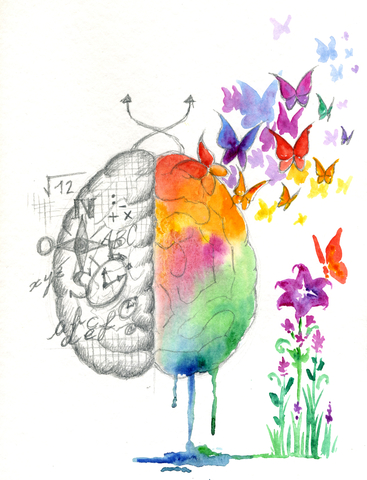Living Right In a Left Brain World Part 1
It’s not enough to have a good mind. The main thing is to use it well.
— Rene Descartes
One way to use your brain well is to learn to tap into your right-brain’s wisdom, creativity, insight and spiritual connection. Once you bring those images to consciousness, you can use them to assist you in your daily life.
Your conscious mind is your left-brain and your subconscious mind is your right-brain.
 Being in a right-brain state changesyour brain chemistry from stress (fight or flight) to relaxation response. It is accompanied by a feeling of relaxation and connection. Our brains are divided from front to back into two halves, looking something like an overgrown walnut.
Being in a right-brain state changesyour brain chemistry from stress (fight or flight) to relaxation response. It is accompanied by a feeling of relaxation and connection. Our brains are divided from front to back into two halves, looking something like an overgrown walnut.
Left-brain involves our conscious, cognitive, logical, rational and linear way of thinking. Left-brain represents masculinity, doing, choice/action, will, understanding, meaning, mathematics,and linguistic talents. It is also analytical, technical, problem solving, financial, and organizational.
Right-brain specializes in our emotional and creative ways. It represents femininity, feelings, the subconscious, memory and association, and non-linear thinking. It is intuitive, imaginative, perceptive, conceptive, spatial, integrative, and innovative.
Right side of the body is controlled by left-brain. Left side of the body is controlled by right-brain.
Each side of the brain has a regulated program that instructs the opposite half of the body to move and to record sensations of movement. When the fingers of your right hand make piano movements, brain cells in your left hemisphere send out the signals first. If you stub your left big toe, your right brain registers the pain.
But if you have a stroke or somehow lose function in one part of the brain, another part can take over that function. In that way the brain is holographic. I have been asked if left-handed people are less logical or right-handed people are less intuitive. The answer is that neither statements are true.
In our left-brain dominant society, we are taught to follow the linear road of reality: to begin at point A and follow as straight a line as possible to our destination. We put one foot in front of the other. One step follows another in sequence. We move from past to present to future. We accept only that which we can see, touch, taste, smell and hear. All must make logical sense. Physical reality is solid and impenetrable.
But not everything responds to that linear road. If we follow it exclusively, we miss anything that does not fit within its logic. We miss the wisdom that exists beyond the narrow boundaries of the linear world.
Logic vs. intuition
Our modern society leans towards the logical, the scientific way of thinking. Think of all the knowledge that has been amassed over the centuries, all the comforts developed from science. Logic is about deriving the basic truths from a set of observations or conditions. The conclusions reached must show the reasons or logic behind them. A scientific breakthrough that comes from a dream or intuition must be presented as if it were the result of logic. Otherwise it usually will not be accepted.
On the other hand, intuition is a state of direct knowing. It is often spontaneous and comes without the use of the rational thinking process. You know that you know and that’s that!
All of us use both left and right brain although each of us leans more in one direction or another. But in truth, our left and right brains are always interacting.
We each have a unique combination and balance of using both sides of the brain. Here are some examples of right/left cooperation in action:
- Albert, a hair stylist, gets a flash of vision (right-brain) of the perfect style or cut of a client’s hair. He can see in an instant what outcome he wants. Then his practical (left-brain) mind executes it step by step. The flash of vision is fast and complete. He then enjoys the practical, linear steps of getting to the vision. The right-brain flash of intuition is an important balance for him that he recognizes.
- Caroline is a writer who much prefers the creative right-brain process and hates the editing left-brain part of writing. Yet both are important functions of the art. She often gets out her coloured pencils and colouring book and colours for a while to stimulate her right brain before she writes.
- David reads fiction for a short time before he starts a painting session.
- John, the amazing CEO of a big company, knits when he needs a creative idea or has to solve a problem.
- Lauren stands in the bathroom in one particular spot and grooms to get breakthroughs.
We need to understand how to help our left and right brains work together to create a whole-brain consciousness. Studies have shown that when healers are healing they have both left and right brain frequencies in sync. The ideal is to use the whole brain working together, in sync with itself, thus creating a synergy of the two halves that enhances all brain functions. This allows us to harness greater creativity, optimal learning, problem solving, health and personal quality of life.